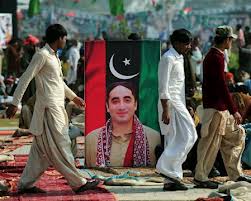
(Credit: dailystar.com.lb)
THE battle lines have been drawn as polling day closes in. The outcome of these elections, now less than a week away, is perhaps the most difficult to predict since the 1970s. There may be many surprises waiting as the battle at the hustings intensifies.
It is no more a traditional fight for the crown between the two long-term rivals, the PPP and PML-N. The meteoric rise of the Pakistan Tehreek-i-Insaf (PTI) has completely changed the country’s electoral scene. A quintessential outsider is now challenging the domination of the two established parties.
Seemingly, the elections have essentially become a contest between the PML-N and PTI with the region along the Grand Trunk Road in the Punjab becoming the main battleground. Various opinion polls vindicate the widespread perception.
While the two front runners are jostling it out, the PPP seems to be out of breath. Its lacklustre election campaign does not give much hope to party loyalists. Is this the twilight moment for the party which has been at Pakistan’s political centre stage since its inception some four decades ago? Maybe, or not as yet. But the decline of the PPP’s political base is shocking.
Leaderless and rudderless sums up the current state of the PPP, as it struggles to stay in the critical race. There are no big election rallies nor is there any central leader to galvanise the electorate. For the first time, the party has gone into the election campaign without a Bhutto to lead it. Therefore there is no Bhutto charisma to revive the party’s fast-diminishing populist credibility.
Not only was Benazir Bhutto there to start the party’s 2008 election campaign, her assassination drew sympathy votes bringing back the party to power after a hiatus of 11 years. But now a critical peg to hang on to and a fight-back to regain the ground lost during its not so enviable five-year term in office appear to be missing. The party’s TV campaign advertisements reflect its desperation to clutch on to the past and resort to the politics of martyrdom.
It is largely a negative campaign targeting the past record of the PML-N. There is nothing about its own performance or what the party will offer to the electorate in the future. This illustrates the defeatist mindset of a party that is unable to defend its incompetence and corruption-ridden rule. It is a sad commentary on the state of what was once the most formidable political force in the country.
Over the past 40 years, the PPP went through many ups and downs, but it has never seen its fortunes plummeting so rapidly. It is a party now trying to live off its past without any hope for the future. One of the greatest assets of the party that kept it alive through the worst of times was its contact with the masses. That seems to have been completely lost due to the party’s new ethos of political wheeling and dealing and buying loyalties.
Not surprisingly, this new political culture is manifested in the emergence of people of the ilk of Manzoor Wattoo, Anwar Saifullah, Faryal Talpur and Owais Muzaffar ‘Tappi’ as the faces of the party. The jiyalas have long disappeared, leaving the party soulless.
The attempt to launch Bilawal Bhutto Zardari to infuse some life into the party’s dead election campaign seems to have failed because of his reported falling out with his father and paternal aunt. In any case it would have been very difficult for an untested young man with little understanding of the realities and complexities of the country’s politics to boost the flagging morale of the party and to win votes.
For long, the party’s support base in the urban areas particularly in Punjab has been shrinking, but it now seems to be heading to an expulsion there with the PTI and PML-N now fighting for the urban middle-class votes. The party’s only hope is to scavenge some seats because of the divided votes between the two main contestants.
The PPP has largely become a rural-based party with its support mainly concentrated in feudal-dominated Sindh and south Punjab. Yet, it seems hard to predict whether it can maintain its hold in those regions too in the elections. While the party is most likely to retain its domination in Sindh, it may not get the same margin of victory. The failure of the PPP government to deliver on its promises to its constituents has also eroded the party’s vote bank in its stronghold.
Having said that, the PPP may be down but it is certainly not completely out of the race. Even with a far fewer number of seats, the party will remain relevant in an expectedly fragmented house, though it is likely to not be in a position to lead the coalition.
In a scenario where the PTI gets close to the number of seats as the PML-N, it would become much more difficult to form a viable and effective coalition government. In a hung parliament the PPP with its majority in the Senate will hold the balance.
But the real issue is whether a rudderless PPP with a declining mass base is able to emerge united after a possible electoral setback or whether the situation would lead to the complete unravelling of a party that still claims to espouse liberal credentials.
The May 11 elections are indeed important for the party, but a more critical issue is whether it can ever regain its lost mass base. This is only possible if the party reforms itself in a changed political, social and cultural environment. It is certainly an uphill task for a party that depends on its past and does not seem to be looking towards the future.
The writer is an author and journalist.
